Great Blue Heron – Ciconiiformes Ardeidae Ardea herodias
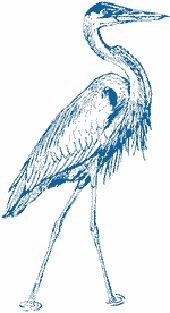 |
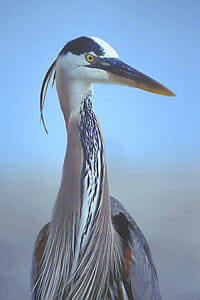 |
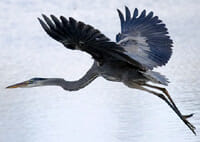 |
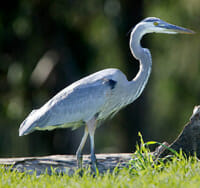 |
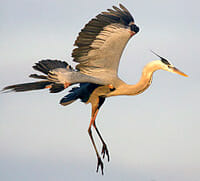 |
Identification & Description:
• Large, gray bird.
• Long legs
• White crown stripe.
• Sexes similar
• Huge long-legged long-necked wader
• Usually holds neck in an “S” curve at rest and in flight
• White morph all white with pale legs, long, thick yellow bill.
• Black plume extending from behind eye to off the back of the neck.
• Shaggy feathers on neck and back.
• Bluish gray back, wings, and belly.
• Reddish or gray neck.
• Size: 97-137 cm (38-54 in)
• Wingspan: 167-201 cm (66-79 in)
• Weight: 2100-2500 g (74.13-88.25 ounces)
Adult:
• White crown and face
• Black plume extending from above and behind eye to beyond back of head
• Brownish-buff neck with black-bordered white stripe down center of foreneck
• Blue-gray back, wings and belly
• Black shoulder
• Shaggy neck and back plumes in alternate plumage
Immature:
• Black cap
• Brownish-gray back and upperwings
• Lacks shaggy neck and back plumes
• Lacks black plume extending from behind eye
“Great White Heron”:
• White morph of Great Blue Heron
• Large yellow bill
• Yellow legs
• White plumage
• Single white plume extending back from above eye
• Found only in South Florida, rarely north along the coast
Similar species:
Tricolored Heron has white belly. Reddish Egret and Little Blue Heron are smaller, and lack white on head and yellow in bill. “Great White Heron” could be confused with Great Egret but is larger, with yellow legs and the single head plume coming from behind the eye.
Life History Groupings
• Migration Status: N/A
• Breeding Habitat: Wetland-open water
• Clutch Size: 3-6
• Length of Incubation: 28 days
• Days to Fledge: 56-60
• Number of Broods: 1
• Diet:
Mostly: Fish
Lesser Quantities of: Aquatic Invertebrates, Small Mammals & Reptiles or Amphibians
Facts
• The white form of the Great Blue Heron, known as the “great white heron,” is found nearly exclusively in shallow marine waters along the coast of very southern Florida, the Yucatan Peninsula, and in the Caribbean. Where the dark and white forms overlap in Florida, intermediate birds known as “Wurdemann’s herons” can be found. They have the bodies of a Great Blue Heron, but the white head and neck of the great white heron.
• Although the Great Blue Heron eats primarily fish, it is adaptable and willing to eat other animals as well. Several studies have found that voles (mice) were a very important part of the diet, making up nearly half of what was fed to nestlings in Idaho. Occasionally a heron will choke to death trying to eat a fish that is too large to swallow.
• Great Blue Herons congregate at fish hatcheries, creating potential problems for the fish farmers. A study found that herons ate mostly diseased fish that would have died shortly anyway. Sick fish spent more time near the surface of the water where they were more vulnerable to the herons.
Other Names
Grande Héron (French)
Garza morena, Garza blanca granda, Gallinaza (Spanish)
The great blue heron belongs to the heron family, Ardeidae, in the stork order, Ciconiiformes, and is classified as Ardea herodias.
Great Blue Heron, common name for a tall, long-necked North American wading bird. It lives close to water on marshes, swamps, tidelands, and inland rivers and lakes. It nests in the spring and summer from southeast Alaska south into Mexico, the Galápagos Islands, and the West Indies, and winters over much of its breeding range.
At about 117 cm (about 46 in) in length with a weight of 2 to 3 kg (5 to 8 lb), the great blue heron is the largest North American heron. It has a wingspan of about 1.8 m (about 6 ft). Its body and wings are mostly bluish-gray, and it has a black shoulder patch and a black belly. The head is white, with a black stripe along the sides of the top, or crown. The neck is gray, with black streaks down the center front. The bill is long, sharp, and yellowish, and the legs are long and black. During the breeding season, adults of both sexes have long, showy feathers, or plumes, on their head, neck, and back.
Great blue herons fly with great, slow wing beats, their legs straight back, and their long neck tucked back on their shoulders in an S shape. They are rapid flyers, reaching speeds of up to 55 km/h (35 mph). While flying, they may give a honking call, and when startled, they utter a series of loud, harsh croaks.
The great blue heron’s diet consists mainly of small fish. It most often forages in shallow water, standing still or walking slowly while waiting for a fish to swim near, then quickly striking at the prey with its long bill. It also eats shellfish, frogs, salamanders, turtles, and small water birds and will hunt on land for insects, snakes, and small mammals and birds. The great blue heron feeds mostly in the daytime, especially at dawn and dusk.
Nesting takes place from November through May, depending on location. Great blue herons nest together in groups of from a few pairs to hundreds, often with other heron species, such as the great egret. Their nesting areas are usually in trees or shrubs near water. During courtship, the male performs a variety of displays to attract the female, such as stretching his neck forward with his head and neck feathers erect, then snapping his bill shut, or flying in a circle above the nesting area with his neck extended.
The male and female build a nest, which is a large platform of loosely woven sticks. The male gathers the nesting material and presents it to the female, who uses her bill to work it into the nest. New nests may be about 45 cm (about 18 in) across and older nests that have been expanded for several years can reach 1 m (over 3 ft) across. The nests are built 6 to 30 m (20 to 98 ft) above the ground. On islands, where the birds are safe from predators, the nests may be built directly on the ground. The same nesting sites may be used year after year.
The female lays three to four large pale blue-green eggs one or more days apart. Both parents take turns incubating, or warming, the eggs by sitting on them. To keep the eggs evenly warmed, the parent stands up and turns them with its bill about once every two hours. The young hatch after 25 to 29 days in the order the eggs were laid. Both parents feed the young by regurgitating partially digested fish. Usually only one or two of the oldest chicks survive, since they are larger and better able to compete for food. The young herons begin to fly about 60 days after hatching and leave the nest after another 5 to 30 days.
The great blue heron population is large and stable, although disturbance by humans or tree-climbing predators such as raccoons may cause herons to abandon a colony.